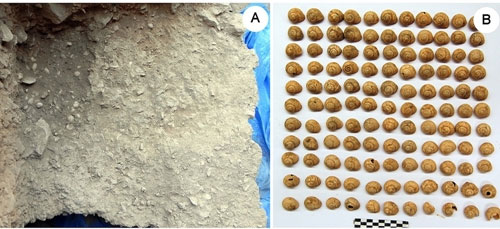Ancient people eat snails from 30,000 years ago
A new archaeological excavation in Spain reveals that humans eat snails from the Paleolithic period 30,000 years ago.
Archaeologists discovered hundreds of shells near fire and the rest of many other animals along a cliff shelter in Spain. The findings suggest that those who lived in the Paleolithic era on the Iberian Peninsula ate 10,000 years earlier than their neighbors in the Mediterranean, Livescience reported.

Fire furnaces (a) and shells are burned (b) in the rock shelter of the ancient people.(Photo: Fernández-López de Pablo)
'Snails probably don't provide a significant amount of calories in the diet of the Paleolithic inhabitants, but it provides a good amount of vitamins A, B3, B6 and B12 and many other important nutrients' , archaeologist Javier Fernández from the Spanish Institute of IPHES said.
'Although snails are very much present in the Paleolithic era, it is very complicated to explain them as a food source during this period,' he added.
Fernández and colleagues conducted excavations in the Benidorm region of Spain three years ago, when they encountered the first sign of ancient inhabitants. In the new discovery, an ancient furnace, stone tools, animal bones, hundreds of shells showed evidence of ancient cooking. The bones of many other animals at the scene were broken by humans to get bone marrow.
'Burning snail shells belong to the same species of Iberus alonensis, today they often appear in Spanish dishes like pilaf. Near the snail shells are charcoal of pine and juniper trees, similarly sized snails show that they are caught when they reach their maximum size, about 1 year old , 'said Javier Fernández.
It is still unclear why people eat snails at this time but not earlier, but human culture has undergone a transition at this time - people know how to use resources. in a more effective diet.
- Strange characteristics of snails
- Strange ability of snails
- Dead snails stuck in amber 99 million years
- Huge snails spreading worries in America
- Train dogs to kill invasive snails
- Giant snail inflicting in America
- Found fossils 500 million years of snail relatives
- He alerted the giant foreign snail to destroy the garden
- Detecting exotic snails swimming like butterflies in the ocean
- Throw snails away 20m to clean your garden
- China banned the sale of poisonous mud snails
- Note when eating snails to avoid processions into the body
 Discovered an ancient centipede fossil 99 million years old
Discovered an ancient centipede fossil 99 million years old Discovered bat-like dinosaurs in China
Discovered bat-like dinosaurs in China Discovered a 200-year-old bronze cannon of the coast
Discovered a 200-year-old bronze cannon of the coast Discover 305 million-year-old spider fossils
Discover 305 million-year-old spider fossils